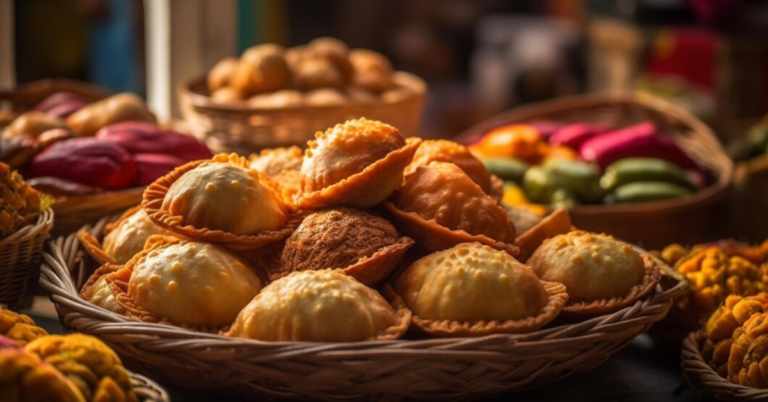Empadas, a beloved delicacy hailing from Portugal, have made their mark on the global culinary scene with their irresistible combination of flaky pastry and flavorful fillings. These delectable treats, also known as empadinhas in Brazil, hold a special place in the hearts and palates of food enthusiasts worldwide. Join us on a gastronomic adventure as we delve into the origins, evolution, variations, and recipes of this delightful culinary gem.
Origin and History
Portuguese Roots: The history of empadas can be traced back to Portugal, where they originated as savory pies during the medieval period.
Colonial Influence: Portuguese explorers introduced empadas to their colonies, including Brazil, Angola, and Mozambique, where they underwent further adaptation and became ingrained in the local culinary traditions.
Evolution Over Time: From humble beginnings, empadas have evolved into a versatile snack enjoyed in various forms across different cultures.
The Anatomy of Empadas
Pastry: The hallmark of empadas lies in their buttery, flaky pastry crust, achieved through a careful balance of flour, butter, and water.
Fillings: Empadas boast an array of savory fillings, ranging from tender meats like chicken, beef, or seafood to vegetarian options like spinach, cheese, or mushrooms. The filling is often seasoned with herbs, spices, and aromatics to enhance its flavor profile.
Assembly: The art of assembling empadas involves encasing the filling within the pastry crust, creating a compact and portable snack that is as visually appealing as it is delicious.
Regional Variations
Portuguese Empadas: In Portugal, empadas come in various shapes and sizes, with popular fillings such as chicken and chorizo or codfish and potato.
Brazilian Empadinhas: Brazilian empadinhas are smaller in size compared to their Portuguese counterparts and are commonly served as appetizers or party snacks. Traditional fillings include shredded chicken, shrimp, or heart of palm.
Angolan and Mozambican Empadas: In Angola and Mozambique, empadas reflect a fusion of African and Portuguese influences, with fillings featuring local ingredients like spicy peri-peri chicken or prawns with coconut milk.
Global Adaptations: Empadas have transcended borders and inspired unique interpretations worldwide, with chefs incorporating local flavors and ingredients to create innovative variations.
Empadas in Culinary Culture
Cultural Heritage: Empada’s hold cultural significance in Portuguese-speaking countries, where they are enjoyed as comfort food and cherished as a symbol of culinary heritage.
Celebratory Occasions: Empadas are often served during festive occasions such as weddings, festivals, and family gatherings, symbolizing abundance, togetherness, and joy.
Street Food Culture: In urban centers and markets, empadas are a popular street food snack, offering a convenient and satisfying option for on-the-go consumption.
Empadas in Modern Cuisine
Gourmet Variations: Contemporary chefs and restaurateurs have elevated empadas to gourmet status by experimenting with premium ingredients, creative fillings, and innovative presentations.
Health-Conscious Options: With growing awareness of dietary preferences and restrictions, chefs are developing healthier versions of empadas using whole-grain flours, lean proteins, and plant-based fillings.
Global Fusion: Empada’s have become a canvas for culinary fusion, with chefs infusing flavors from diverse cuisines such as Asian, Mediterranean, and Latin American to create fusion empada’s that tantalize the taste buds with unexpected combinations.
Homemade Empadas
Pastry Preparation: Master the art of making flaky pastry from scratch using simple ingredients and techniques.
Filling Recipes: Explore a variety of filling recipes, from classic chicken and mushroom to exotic combinations like curry vegetable or Thai-inspired tofu.
Baking Tips: Learn the secrets to achieving perfectly baked empada’s, from proper sealing techniques to optimal baking times and temperatures.
Empadas
Culinary Tourism: Embark on a culinary journey to explore the origins of empada’s in Portugal or savor authentic renditions in Brazil, Angola, or Mozambique.
Cooking Workshops: Participate in cooking workshops and classes to learn the art of making empada’s from local chefs and culinary experts.
Culinary Souvenirs: Bring home the flavors of empada’s by purchasing artisanal pastries, spices, and cooking utensils from specialty shops and markets.
Conclusion
Empada’s epitomize the rich tapestry of culinary traditions that have been passed down through generations, connecting people across continents through a shared love for good food. Whether enjoyed as a humble street snack or a gourmet delicacy, empada’s continue to captivate taste buds and inspire culinary creativity, ensuring their place in the annals of gastronomic history for years to come. So, the next time you bite into a flaky pastry filled with savory goodness, take a moment to savor the legacy of empada’s and appreciate the culinary journey that brought them to your plate.

